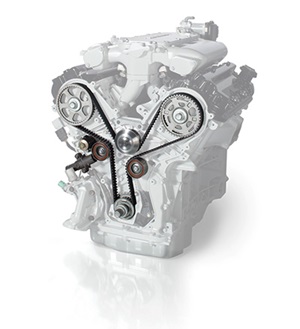The timing belt is responsible for synchronising the actions of the camshaft and crankshaft to keep your valves moving safely and your engine running smoothly. In some vehicles, the timing belt may actually be a chain. In this article, we'll take you through why the timing belt now stands strong as the choice of OE manufactures, when compared to the timing chain, as the preferred mechanical timing system of your car’s internal combustion engine.
A Drive Back in Time
Historically, valve operation was a side valve (flathead engine), then an overhead valve (pushrod engine), and, lastly, an overhead camshaft (internal combustion engine). The most modern, stream-lined, and reliable technology is the timing belt, which, like the overhead camshaft, is used in internal combustion engines. The timing belt brought with it smoother, quieter engine operation, in addition to much-anticipated higher engine speeds.
engine). The most modern, stream-lined, and reliable technology is the timing belt, which, like the overhead camshaft, is used in internal combustion engines. The timing belt brought with it smoother, quieter engine operation, in addition to much-anticipated higher engine speeds.
Modern technology has allowed for the creation of thinner belts, using no more space than that of a timing chain, instead of the thicker, wider-toothed rubber belts. Today, timing belts rely heavily on nitrile rubber, or hydrogenated nitrile butadiene rubber, which, unlike the former rubber construction, stands up to contaminants like oil and coolant. To better understand timing belt benefits, Gates Australia – a leading provider of PTFE Teflon® timing belt solutions – answer some of your most vexing timing belt questions, alongside one of their Australian distributors, Sparesbox.
Why does my vehicle need a timing belt?
A timing belt, or timing chain, is a crucial part of every internal combustion engine, as it plays a major role in an engine’s mechanical timing. Synchronising the rotation of the crankshaft and camshafts, the timing belt ensures your engine valves open and close at the right time, working in conjunction with the distribution of air to the pistons.
What is the difference between timing belts and timing chains?
Prior to the 1960s, vehicle manufacturers and car enthusiasts came to prefer the use of timing chains due to their longevity and strength. Today, timing chains are less resilient than their high-quality belt counterparts. With Gates’ premium PTFE timing belt technology, for example, motorists can enjoy a quieter driving experience and optimal car performance, thanks to increased timing precision.
Timing belts should be replaced every 64,000 km to 160,000 km (dependent on your vehicle make and model – see your user handbook or speak to your dealer or mechanic). If you accidentally prolong your service interval – or are just very unlucky! – your timing belt may break. When broken, timing belts often cause less damage compared to timing chains, as the latter are made from solid metal that can rip through your engine components.
The level of damage caused by a broken timing belt can be heavily influenced by your engine type. If you have a non-interference engine, a broken timing belt often leads to the installation of a timing belt kit, versus the installation of a whole new engine. If you have an interference engine, a timing belt can cause a similar level of damage if it breaks that a timing chain inflicts. If you’re not sure what kind of engine you have, and have a modern car, it’s likely an interference engine; they’re popular as they maximise the engine’s compression ratio. Easily check your engine type by looking at your VIN number or asking your car manufacturer.
Having said that, interference or not, timing belt failure can still cause significant damage and it’s important to strictly stick to your manufacturer’s replacement intervals and get your belt checked each time you get your car serviced, even if it’s not due for replacement.
A few other important benefits of installing a timing belt include:
- The elimination of the need for frequent, dirty lubrication (a timing chain is lubricated by engine oil), as the belt is flexible and doesn’t produce metal-on-metal contact.
- Reduced noise and vibration.
- A cost-effective solution for your vehicle’s engine, as installing a timing belt system, generally, be less expensive than the chain.
In conclusion, the timing belt is not only the solution of the past and present, but also the future. With consumers continuing to desire smooth and efficient, yet powerful, internal combustion engines, many of the top manufacturers fit their new vehicles with timing belts, including Toyota, Ford and Mitsubishi. With unparalleled quality and performance, timing belts are here to stay in our vehicles, and on our roads.